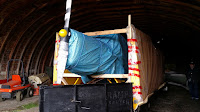Transporting the Auster C-FLOE from the Farm to Langley
 |
| Ready for transport |
 |
| Left side showing wrap |
 |
| Tail wheel strapped down |
Now, we were not going to fly that aircraft through the rocky mountains in late October or early November. That would constitute poor airmanship. While it is certainly possible if the weather was good, such as in June or July, the likelihood of a quiet flight down the VFR routes was extremely slim, and I was just getting settled into a new work assignment. Not a good time to be randomly stuck in Brooks, Alberta, waiting for weather. Which has happened before.
 |
| Inside from the back |
The drive to Langley was to be a two day affair. The first day we planned on driving out to Edson, Alberta to stay with a friend over night. The second day we would drive past Jasper and Kamloops, and then down the Coquihalla highway to Langley. We chose that route because it is actually quite wide and flat, and four lanes wide for most of the way. That works out to two fourteen hour days on the road. I would do the driving and my father would supervise! |
| Barney seems very dubious about this endeavor |
 |
| Checking the load |
The GPS, of course, decided to pack it in just as we needed it. We stuck to major roads and kept downtown on our right. Once we were on the west side of town we kept to a north course and it was inevitable that we would make it back to the highway. The sky was completely clear and the air was warm.
The drive to Edson was uneventful and my friend welcomed us warmly. It was great to unwind, pet their beautiful young dog, and go to bed after a few drinks.
 |
| A snow covered early start |
It was a bit of a white knuckle drive. I slowed down but the other drivers didn't seem to care much and shot past us through the three inches of snow and slush. The heavy load and truck did well and the four wheel drive stability system was helpful. I was also hurting just a bit from the previous night's fellowship (whiskey). Once the snow let up a bit and daylight fought its way through the driving got much easier. A short stop for breakfast also helped a lot.
The snow through the pass kept getting deeper. The drive up the hill was a long one and I kept an eye on the transmission temperature. We drove by several people in the ditch (they all had emergency vehicles with them) and I could swear that a few of them were the people who passed us earlier, but it would be hard to be sure.
The main irritant now was the remaining flapping plastic. The wet snow seemed to be working it loose as was the slushy spray from passing vehicles. We stopped to adjust it a few times but it was just working loose and flapping more.
We got really worried about the possible damage and wear to the fabric so at the top of the pass we stopped at a rest area, and cut all the remaining plastic and tarps away except for the tarp over the engine and cockpit. The fabric is tough and weather-tight, and the weather was clearing up. It was still well below zero, with a bit of a wind, and uncomfortable with our wet bare hands handling all the bitter ropes and tarps and knives.
Down the other side of the pass it did warm up and the highway was clear. This was a huge relief to me. The weather for the rest of the drive was great - even the Coquihalla highway.
 |
| A source of many questions |
We arrived in Langley late Sunday night and backed it up to the hanger door safe and sound. I had to go to work the next morning, so my father went in to supervise the unloading in the hanger. It was a nostalgic moment although he would never admit it. That aircraft had been part of our family since I was a teenager.
I went in to the regional registration office in downtown Vancouver on Monday morning and handed in the de-registration papers. I got a little choked up explaining the disposition of the aircraft to the clerk. Dad flew home the next day on a commercial flight: I am wise enough to not fly CF-NZB over the mountains in November, as well.
 |
| Safe in the hanger at Langley |
We managed to get him the confirmation letter for the deregistration. TC was actually very efficient in that they sent the letter within two weeks. The Australian regulator could not seem to find it.
I look forward to seeing the aircraft back in service and all put together and if I get any photos I'll post an update.

Comments
Post a Comment